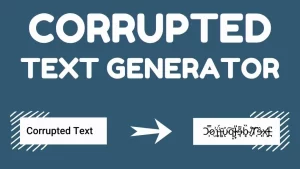Welcome to the world of text corruptor, a fascinating tool that has become increasingly popular among creatives looking to add a unique twist to their writing and design projects. Text corruptors are software programs that can generate distorted, mangled, or otherwise altered text output, providing a fun and creative way to experiment with language and typography. We will examine the fundamentals of text corruptors in this blog article, including how they operate, their practical applications, and their use in digital art and creative writing. We’ll also go through some ethical issues to consider and some drawbacks and hazards of utilizing a text corruptor.
So, this post will provide you with a thorough introduction to the world of text corruptors and motivate you to advance your creativity whether you’re a writer, designer, or simply someone who loves to mess with words.
How does a text corruptor work?
A corrupted text generator is a software program that uses algorithms to generate distorted or altered text output. The exact workings of a text corruptor can vary depending on the specific program, but most operate by applying a set of rules or formulas to existing text. These rules can involve changing individual letters or characters, substituting words with synonyms, or rearranging the order of words or phrases. Some text corruptors also allow for customization, enabling users to specify which types of alterations they want to apply to the input text.
In addition, many text corruptors use machine learning or other artificial intelligence techniques to learn from and adapt to the input text they receive. This can result in more natural or nuanced alterations that mimic the style or tone of the original text.
Text corruptors are designed to generate unexpected, unpredictable, and sometimes even nonsensical output that can be used to add a unique flair to writing and design projects. While they may not be suitable for every situation, they can be a fun and creative tool for those looking to experiment with language and typography in new and exciting ways.
Using a text corruptor in detail
Using a text corruptor effectively involves understanding how to get the most out of the program’s features and how to customize the output to suit your needs. Here are some tips and tricks for using a text corruptor:
- Experiment with different types of text corruptors: There are many different types of text corruptors available, each with its unique features and output styles. Experimenting with different text corruptors can help you find the one that best suits your needs and preferences.
- Adjust the settings: Most text corruptors allow you to adjust various settings to customize the output. For example, you might be able to choose the degree of distortion, the level of randomness, or the specific types of alterations you want to apply. Experimenting with these settings can help you achieve the desired effect.
- Combine multiple outputs: Another way to get creative with text corruptors is to combine multiple outputs from the same or different programs. This can create even more unpredictable and unique results.
- Use it as a tool for inspiration: Text corruptors can be a great tool for generating ideas and inspiration. Try using the output as a writing prompt, or incorporate it into a design project as a starting point for further creative exploration.
- Proofread and edit the output: While text corruptors can be a fun and creative tool, they are not always perfect. It’s important to proofread and edit the output to ensure that it makes sense and is grammatically correct before using it in a project.
Using a corrupted text generator requires a balance of experimentation and intentionality. By playing around with the settings and output, you can find the best ways to incorporate it into your creative process and add a unique flair to your writing and design projects.

Creative applications of text corruptors
Text corruptors offer a wide range of creative applications across various fields, including digital art, writing, and music. Here are some of the most popular creative applications of text corruptors:
- Digital art: Text corruptors can be used to create visually striking digital art pieces that incorporate distorted or altered text. By adjusting the settings of the text corruptor and experimenting with different fonts and styles, artists can create unique and intriguing designs that incorporate text as a central element.
- Writing prompts: Text corruptors can also be used to generate creative writing prompts. By inputting a specific phrase or keyword into the text corruptor, writers can receive a distorted version of the input, which can spark new ideas and inspiration.
- Poetry and songwriting: Text corruptors can also be used to generate unique and unconventional poetry or song lyrics. By applying a set of rules or formulas to existing text, text corruptors can create surprising and unusual combinations of words and phrases that can serve as a starting point for a new piece of writing.
- Graphic design: In graphic design, text corruptors can be used to create visually striking typography or to add a unique flair to existing designs. By experimenting with different settings and output styles, designers can create text that stands out and captures the viewer’s attention.
- Social media: Text corruptors are also popular on social media platforms like Instagram, where users can incorporate distorted or altered text into their posts as a way to add visual interest or express their personality.
Text corruptors offer a fun and creative way to experiment with language and typography across various fields. By incorporating text corruptors into their creative process, artists, writers, and designers can create unique and intriguing works that stand out from the crowd.
Risks and limitations of using a text corruptor
While text corruptors can be a fun and creative tool, there are also some risks and limitations to be aware of. Here are some of the potential risks and limitations of using a text corruptor:
- Limited accuracy: While text corruptors can generate surprising and unique results, they are not always accurate or grammatically correct. Depending on the specific program and settings used, the output can sometimes be difficult to understand or even nonsensical.
- Copyright infringement: Using a text corruptor to generate content that closely resembles existing works could potentially infringe on copyright laws. It’s important to ensure that any output generated with a text corruptor is sufficiently different from any existing works.
- Ethical considerations: Depending on the context in which a text corruptor is used, there may be ethical considerations to keep in mind. For example, using a text corruptor to generate fake news or misinformation could have negative consequences for individuals or society as a whole.
- Limited practical applications: While text corruptors can be a fun and creative tool, they may not always be suitable for practical applications. In some cases, the output generated by a text corruptor may not be suitable for professional use, such as in business or academic contexts.
- Overreliance on technology: Using a text corruptor to generate content can also lead to an overreliance on technology, potentially limiting one’s ability to create original content without the use of such tools.
Overall, while text corruptors can be a useful and creative tool, it’s important to be aware of their limitations and potential risks and to use them responsibly and ethically. As with any tool or technology, text corruptors should be used in moderation and in a way that is appropriate for the specific context and purpose
FAQs:
Q: What is a text corruptor?
A: A text corruptor is a program or tool that generates distorted or altered versions of text, often used for creative purposes such as generating writing prompts or creating digital art.
Q: How does a text corruptor work?
A: A text corruptor works by applying various algorithms or formulas to existing text, resulting in a distorted or altered version of the input. Depending on the specific program and settings used, the output can vary widely in terms of style and degree of distortion.
Q: What are some creative applications of text corruptors?
A: Some creative applications of text corruptors include digital art, writing prompts, poetry and songwriting, graphic design, and social media.
Q: What are the risks of using text corruptors?
A: Some potential risks of using a text corruptor include limited accuracy, copyright infringement, ethical considerations, limited practical applications, and overreliance on technology.
Q: How can I use a text corruptor effectively?
A: To use a text corruptor effectively, it’s important to experiment with different programs and settings, adjust the output to suit your needs and preferences, and proofread and edit the output before using it in a project. It’s also important to use text corruptors responsibly and ethically, and to be aware of their limitations and potential risks.
If you feel our website useful, before you leave, please help the site with a small action like vote or share to everyone so that it can grow and serve you better. Thank you.



![Async Await c# Error Handling [SOLVED!]](https://mycodebit.com/wp-content/uploads/2023/10/rich-tervet-q2GNdFmhxx4-unsplash-360x240.jpg)

![How to Handle Divide by Zero Error in c# [Complete Guide]](https://mycodebit.com/wp-content/uploads/2023/10/clement-helardot-95YRwf6CNw8-unsplash-360x240.jpg)
